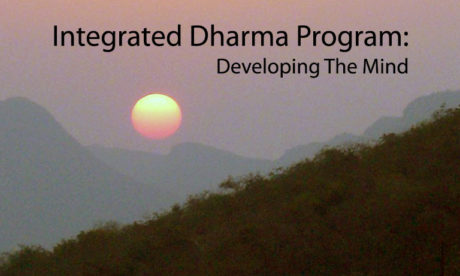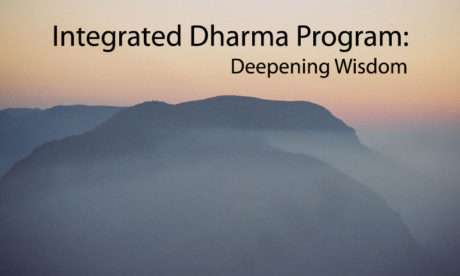Instructor: Andrew Olendzki
Program overview: The Integrated Dharma Program was originally designed to run for a full year, in three parts of four months each, covering Pali Canon teachings on sīla, samādhi, and paññā—ethics, meditation, and wisdom.
THE PROGRAM IS NOW AVAILABLE AS A WHOLE, in a format allowing each student to move through the curriculum at their own pace and in any order.
Integrated Dharma is a new approach to understanding and embodying the teachings of the Buddha. It is intended to bring contemporary people living in the modern world into very intimate contact with the thoughts and words of the historical Buddha. The approach is respectful of the classical tradition and faithful to the original teachings, but also secular in its orientation and focused more on the practical psychology of Buddhism than upon its religious or metaphysical aspects.
Participants are invited to look closely at two ideas presented in the classical texts in each unit, and to investigate the meaning of these teachings in the context of their own lives and their own practice. The passages are short, carefully selected, and presented in a way that is easily accessible. The primary work of the program is not to cover a lot of material, but to penetrate deeply into the meaning of key teachings and see how they are demonstrated in one’s own experience and relevant to one’s own life. Students are encouraged to investigate the teachings slowly, one unit each week, but have access to all the material at once and can take the course at any pace of their own choosing.
Each unit’s downloadable PDF includes two passages from the early Buddhist teachings of the Pali canon as well as accompanying study material. The side-by-side English-to-Pali translation also comes with Andrew’s guidelines for investigating the meaning of the passage in your own experience, suggestions for integrating each teaching into your life, and an explanation of the Pali terms for those who are interested. There are also downloadable audio files for students who want to listen and learn on-the-go. The class unfolds over the course of 16 units, allowing ample time and space for the material to truly sink in and begin to inform your life. The teachings are meant to help you navigate your life in every way: mental, emotional, interpersonal, and spiritual.
The Integrated Dharam Program consists of three parts:
Part One: Living With Integrity
The outline of the course is suggested by a passage in which the Buddha speaks about how to ensure the accurate and authentic preservation of the teachings over time. The passage is presented here and will serve as a model of how the program is structured:
⌘ Text
Numerical Discourses 5.154
These five things
incline toward
the stability,
the non-decline,
and the non-disappearance
of the authentic teaching.
When people:
- carefully hear the teaching;
- carefully learn the teaching;
- carefully remember the teaching;
- carefully investigate the meaning of the teaching they have remembered;
- carefully understand the meaning of the teaching and practice the teaching according to the teaching.
❁ Pali
Aṅguttara Nikāya 5:154
pañcime dhammā
saddhammassa
ṭhitiyā
asammosāya
anantaradhānāya
saṃvattanti.
idha bhikkhū:
sakkaccaṃ dhammaṃ suṇanti,
sakkaccaṃ dhammaṃ pariyāpuṇanti,
sakkaccaṃ dhammaṃ dhārenti,
sakkaccaṃ dhatānaṃ dhammānaṃ
atthaṃ upaparikkhanti,
sakkaccaṃ attham aññāya
dhammam aññāya
dhammānudhammaṃ paṭipajjanti.
⌘ Text – English Reference
Hear the teaching.
A. In the Buddha’s day the teachings were oral, but today we are more accustomed to reading. All materials are offered in .pdf files you can download and print, as well as in .mp3 format, for those who prefer to listen to my reading them.
B. Each short text is given in an accessible form:
- some repetitions have been condensed
- some embellishments have been removed
(e.g.: the constant insertion of proper names) - gender has been universalized where possible
(e.g.: ‘one breathes’ rather than ‘he breathes’) - and the generic word ‘person’ replaces specific nouns (monk, brahmin, etc.).
C. The translations published by Wisdom Publications have been followed as a default, but I have modified these in significant ways and thus take full responsibility for all the translations.
D. References are provided for each passage, in both English and Pali, so participants can easily find the original text, see the context from which they are taken, and compare various translations.
❁ Pali – Pāli Reference
Hear the teaching.
A. Each text is also provided in Pali, so you can see the original and compare it with the translation.
B. The sentences are broken down into phrases, following the natural structure of the oral literature. These are presented side-by-side with the English translations so students can see with greater clarity the relationship between the Pali and the English. For the most part the phrases line up with one another, but the syntax of the languages are different, so sometimes they do not align.
C. An audio file of my reading the Pali text is also provided for each passage, so students can hear what the original sounds like (albeit with and American accent).
D. Those with an interest in Pali as a language, and those who want to understand why some key words are translated as they are, will find this section invaluable. Others can easily bypass and ignore this section.
❖ Comment
Learn the teaching.
A. Comments are offered on each textual fragment, to help participants understand better what is being said in the text. Particular words and phrases are explained, connections are made to other passages or similar themes, and guidelines for interpreting the significance of the text for lived experience are suggested.
B. This list of ‘five things’ is one of several found in the Book of Fives of the numerically-arranged discourses, and has been chosen as the organizing principle of this course because of how clearly and usefully it presents a program for integrating the study and practice of the teachings. Note that the first three have to do with receiving the teachings accurately and with keeping them vital by regularly ‘bearing them in mind’, while the last two are concerned with working with them in a living way and actually embodying the teaching in one’s own life and experience.
C. The Buddha taught orally, as did all teachers in his day, and laid out a remarkably consistent and coherent curriculum throughout the forty-five years he was teaching. Naturally the accurate preservation of this legacy was a matter of great importance, and ‘hearing’, ‘learning’, and ‘remembering’ the teachings were necessary to ensure that this wisdom was passed on through the ages rather than being lost soon after the passing away of the Buddha. The project succeeded quite spectacularly, and we can be fairly sure that these texts have been preserved with great fidelity.
D. The whole point of preserving these teachings so carefully, however, is so that all who encounter them can ‘understand their meaning’ for themselves and embody the wisdom of the teachings in their own lives. This is done by ‘investigating the meaning’ of the teaching one’s own experience. Indeed the entire body of teachings is merely a ‘finger pointing at the moon’, as so aptly put in later Chinese tradition, and we only fulfill them by engaging directly with our own experience putting the teachings into practice.
♦ Language
Learn the teaching.
A. A more detailed commentary is provided for each textual passage, explaining some of the Pali terms used in greater depth. For those interested in looking more closely at the text, this section helps understand how some words are used and why they are translated as they are. Since Pali is an Indo-European language, and thus distantly related to English, such a close exploration of the language can get us very close to the textures of the Buddha’s instructions and bring out many nuances that are otherwise obscured by translation.
B. The word translated here as ‘true teaching’ (saddhamma) is made by adding the prefix ‘sat-‘ to the word for the teachings (dhamma). On its own ‘sat’ is just a derivative of the verb ‘to be’ (√as), meaning ‘existing’, ‘actual’, or ‘real’, and applied in this way as a prefix it can suggest ‘true’, ‘accurate’, or, as I prefer here, ‘authentic’. At this early stage of the tradition the word ‘dhamma’, refers to what the Buddha is teaching during his lifetime rather than to a larger, deeper, metaphysical ‘Truth’ that pervades the cosmos. The context, too, suggests accuracy in conveying what the Buddha is teaching, taking care that is not diluted or corrupted by other popular ideas.
C. Note: Pali is an inflected language, like Latin and Greek but unlike English, so words can take on very different spellings and shapes according to their context. Thus above, ‘sat+dhamma‘ becomes ‘saddhamma‘, while ‘sat+kacca‘ becomes ‘sakkacca‘, and ‘dhamma‘ can be found in the same passage as ‘dhammassa‘, ‘dhammaṃ‘, and ‘dhammā‘. Don’t be confused by this; words are just more ‘flexible’ in Pali than in English.
D. The central word in this passage is ‘sakkaccam‘, which I have rendered as ‘carefully’ but which can also be taken as ‘respectfully’, ‘thoroughly’, or even, as above, ‘authentically’. Here we have the same prefix (sat=real, true) being added to a form of the verb ‘to do’ (√kr), so ‘sakkaccam‘ (sat+kacca) most directly means something like ‘truly done’ or ‘accurately done’ or ‘authentically done’.
Remembering
Remember the teaching.
A. There is no separate box in this course corresponding to ‘remembering the teachings’. Sending a reminder to your email inbox and posting a new pair of texts each week is the way we ‘recall’ or ‘bring to mind’ the teachings on a regular basis. It is this consistency of contact with the teachings that allows their transformative effects to work on you gradually.
B. The program is structured to deliver a specific teaching to you each week, and you are encouraged to ‘bear it in mind’ often during the week as the circumstances of your life allow. You may work with it one way on the meditation cushion, another way at work, and still other ways as you look at the world around you and engage in your various relationships. The idea is to read the material when it first comes in, and then gradually allow the teaching to ‘sink in’.
C. Although the material is delivered with the regularity of the moon cycles, you may work with it at your own pace. Don’t worry about ‘falling behind’ or ‘keeping up’. By downloading the .pdf and .mp3 files, you can have access to the teachings whenever you like, and keep them for the future.
✭ Investigation
Investigate the meaning of the teaching.
A. The heart of the program consists in participants investigating the meaning of these short texts in their own experience and in their own lives. Guidelines are offered for how to do this, but each of you is encouraged to find new and original ways for investigating the meaning of the text.
B. The teachings are to be investigated both conceptually and experientially. Many of the teachings are subtle and profound, and one will gradually become familiar with their distinctive ideas, specialized vocabulary, and unique ways of looking at things. But most of the time these teachings will be encouraging us to ‘get out of our head’, to steer away from cognitive constructs of the intellect, and to deeply explore the phenomenological textures of lived experience. Both modes are valuable, and it is in the integration of study and practice that true understanding emerges.
C. The words of these texts, coming down to us over twenty-five centuries, are directing your attention to some aspect of how your mind and body operates. The teachings are a map of the landscape of human experience, and its value comes from using it as a guide to walking the terrain itself. As you explore the territory of your own experience with your awareness, you will not only verify the efficacy of these teachings, but will become gradually transformed in the process.
D. Nothing is to be taken on faith in this tradition, or to be accepted merely out of respect for the teacher or the tradition. The Buddha encourages us at every turn to look into the workings of our own minds to see first hand what he is pointing to. So test, question, and explore. Maintain your critical spirit and encourage your common sense. One needs a certain degree of trust in the integrity of the teachers and the teachings, but progress on this path is only made by growth in one’s own direct understanding, by ‘knowing and seeing’ for oneself.
✪ Practice
Practice the teaching in accordance with the teaching.
A. Usually what we mean by ‘practice’ is meditation. The Buddha was lead to his awakening experience by the practice of meditation, continued to meditate daily throughout his life, and encouraged his followers all to meditate regularly as an essential part of his path of transformation.
Guidelines are offered for relating the teachings of each of these texts to meditation practice, where applicable, and to other ways of practicing as appropriate.
B. There is no formal meditation component to this course. It is assumed that participants have a natural interest in meditation, have some exposure and in many cases considerable experience with meditation, and have access to resources that would help either introduce them to the practice or support their ongoing practice. Those of you who already meditate with some regularity will easily find ways to integrate these teachings into your practice, and those who have no experience with meditation are encouraged to take up a regular practice as a supporting condition of the course. Many resources are publicly available for doing this, in many different styles.
C. One of the important things we learn in this course is that there are more ways of ‘practicing’ than engaging in meditation alone. While formal meditation is a crucial tool for understanding the teachings, the guidelines and suggestions for practice offered here cover a wide range of approaches to practice. Participants are encouraged to keep an open mind and explore the many different ways offered in these texts for putting these teachings into practice.
D. Notice that this passage specifies the importance of ‘practicing the teachings in accordance with the teachings’. There are many different ways of meditating within the many Buddhist traditions, as we will see, and there are also many other forms of practice that can be considered ‘meditation’ even though they have nothing to do with Buddhism. Our text is clarifying that the teachings themselves come with an ‘operating manual’, with a set of detailed instructions on just how to meditate in the way taught by the Buddha, and it is these particular practices that are being encouraged here.



